This was published 6 years ago
Petra, beyond the facade: That spine-tingling moment everyone gets
By Kerry van der Jagt
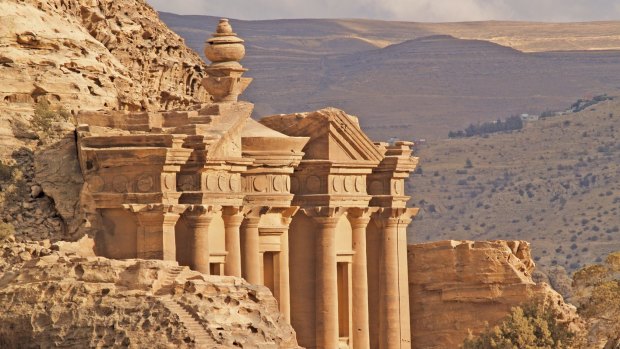
Petra
"You're going to need a four-wheel drive," quips the dreadlocked Bedouin, his bid sounding more like a used-car salesman than an offer for a donkey ride. "It comes with air-conditioning." I decline, continuing on foot along the steep path to the Monastery, one of Petra's lesser-known sights, as Jack Sparrow gallops off in a cloud of dust.
While I'd long associated Petra with Indiana Jones and the Last Crusade, finding cast members of Pirates of the Caribbean, with their kohl-rimmed eyes and swashbuckling ways, was the first of many surprises.
The second surprise was learning that the pillared facade of the iconic Treasury (or Al-Khazneh) is only part of Petra's story – the rest of the sprawling, 60-square kilometre "Rose City" is secreted behind it.
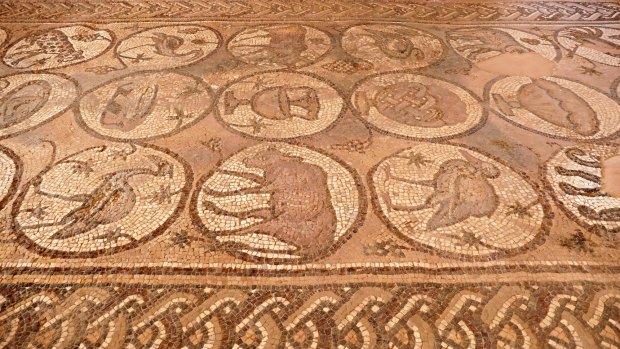
Fragments of Roman Mosaics Ruins at Ancient Byzantine Church in The Lost City of Petra.Credit: Shutterstock
Petra was a major caravan centre established in the third-century BC by the Nabateans, a group of chisel-wielding nomads who carved their rock-capital out of solid sandstone and grew wealthy from their strategic trade position. Through their ability to harness water from the desert they lived a luxurious life – cultivating gardens, growing fruits and bathing like Roman royalty.
Travelling with Bunnik Tours on its 25-day Egypt and Jordan in-depth tour we are enjoying luxury of a different kind – the luxury of time, with three days to ramble amid the rocks, an extravagance not available to day trippers.
From our accommodation in Wadi Musa we stroll to the entrance of the Siq – the canyon of many colours that guards the entrance to Petra. Dwarfed by rose-tinged cliffs we enter the gorge, admiring the detail of the water channels we'd missed on the previous evening's Petra by Night tour.
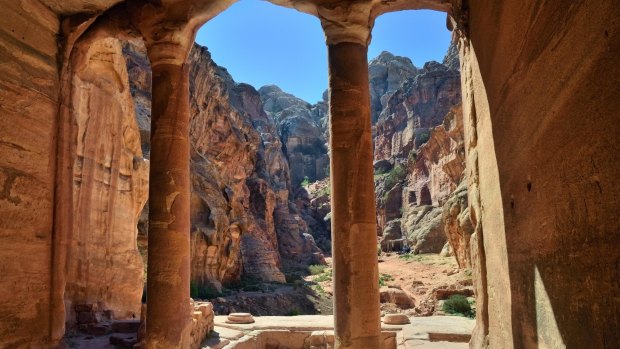
The Garden Hall in the lost city of Petra, Jordan.Credit: Shutterstock
We arrive at the Treasury ahead of the crowds, in time to see the masterpiece as the ancient artisans intended – with the morning light sending its first exploratory beams across the carved surface.
"The Treasury's original function is still a mystery," says our Jordanian guide Ahmad Hussein. "Some say it was a place of worship, others say it was a tomb."
Either way, it is a commanding place, especially that spine-tingling moment when you first see it through the keyhole cleft in the canyon. While the sheer size is impressive, it's the detail of the carving, hewn by hand and preserved by the facade's indentation in the rock wall, that overwhelms.
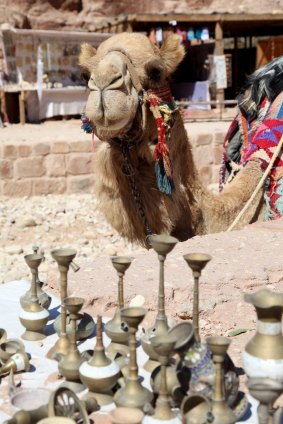
Shopping for trinkets while a camel looks on.Credit: Kerry van der Jagt
As the space in front of the Treasury fills we follow Hussein's lead, away from the touts and into the outer Siq. "The Treasury is just the beginning," he says. "The real riches lie ahead."
In the valley beyond, a wave seems to have swept away the masses, leaving behind a flinty landscape studded with tombs, topped with temples and scratched by trails still trekked by Bedouins as it has been for centuries. Overhead a blue sky scribbled with clouds presses on a landscape so brittle I can hear it creaking.
Hussein is a patient guide, teaching us to notice the small things as well as the large. We stoop to admire overhangs, the ribbons of ochre, red and rust looking like ripples from a dried seabed; we crane our necks at tombs carved into the highest cliffs, round recesses glaring like the hollowed eyes of a skull; and pause to talk to a man selling frankincense, while a bearded camel looks on.
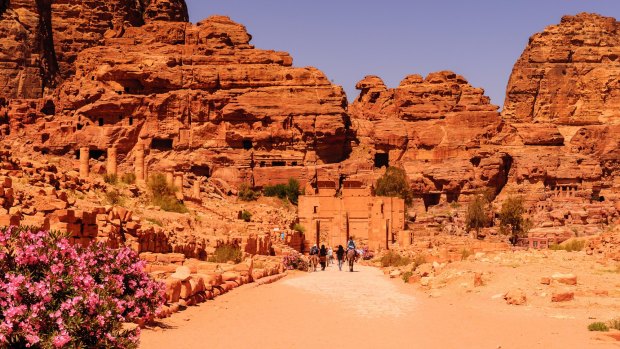
The city of Petra was lost for over 1000 years. Credit: SHUTTERSTOCK
Legends abound – that the Treasury was built to hide the loot of an Egyptian Pharaoh (false), the Monastery was home to monks (false) and that 85 per cent of the city still lies underground (an estimate). What is known is that the Nabatean city prospered for hundreds of years until it was taken over by the Romans around 106AD. A series of earthquakes saw it lost to the western world until 1812 when it was rediscovered by a Swiss explorer.
From the Street of Facades we reach the Theatre, a semi-circle carved into the side of a mountain at the base of the High Place of Sacrifice. Built by the Nabateans in the first century AD it held up to 3000 spectators. When the Romans moved in they did a little remodelling – taking out some tombs here, adding a few extra seats there.
We walk on. Down the Colonnaded Street, with its columns and carriageway, past a public fountain, which was once fed by water channelled from the Siq, and up to the Byzantine Church, with its detailed floor mosaics. The monuments list, containing more then 800 items, is a reflection of the city's Nabatean, Roman and Byzantine eras.
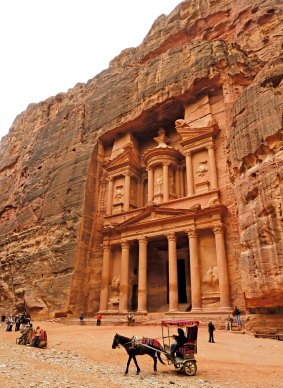
The size of the Treasury at Petra is impressive but it is the detail of the carving that overwhelms.
Picking our way across stones and sand we pass Bedouin stalls, where old women sit around smoky fires, sharing coffee and gossip in equal amounts, while young women hawk trinkets, their button-nosed babies swaddled at their sides.
"Some of the Bdoul Bedouins are direct descendants of the Nabateans," explains Hussein. "However, in 1985 when Petra was declared a UNESCO World Heritage site, the Bdoul were relocated to a nearby, purpose-built village." Apparently, not everyone was happy with the move, with some choosing to stay in caves rather than make the daily trek from the village.
I buy a handmade lock, with an intricate key that turns, while another buys an "antique" camel figurine, a pint-sized imposter we eventually see for sale everywhere. We pay too much for things we don't need, moved by families struggling to make a living out of such a desolate landscape. "Since the Syrian crisis tourism numbers have fallen and people are hurting," explains Hussein. "Jordan is a peaceful country, it's just our neighbours who are bad."
Hussein introduces us to a souvenir-seller named Raami, a gregarious young man with a faint New Zealand accent, the son of Marguerite van Geldermalsen, a minor celebrity in these parts. It was the summer of 1978 when the young New Zealand nurse fell in love with a Bedouin called Mohammad, moved into his cave, got married and subsequently published a best-selling memoir, Married to a Bedouin.
Today, as well as selling signed copies of her book, Marguerite sells sterling silver jewellery made by women from the village. Blending contemporary designs with ancient motifs the jewellery range – Petra Pieces – is part of a project to improve the livelihoods of local women.
It is lunchtime when we reach the Great Temple complex, the largest building in Petra with its own theatre, council chamber, columned courtyard and subterranean drainage system. Looking across the monstrous site it hits me; you'd need at least five days to see all of Petra, particularly if you wanted to tackle the longer hikes such as the Jabal Harun trail to the Tomb of Aaron or the Al-Khubtha trail to the tomb of Sextius Florentinus.
With the remainder of the afternoon at leisure our group decides on the relatively short, though difficult trail to Ad-Deir – the Monastery.
It's at the base of the ancient stairway that I decline the services of the dashing donkey man, choosing instead to climb the 800 steps on two legs not four, struggling up the cliff face like the Nabateans before me. It takes almost an hour to reach the 50-metre high facade, carved into a wedge of mountain it is equally spectacular as the Treasury, though more humbling since we have the place almost to ourselves.
A final climb brings me to a hand-scrawled sign – "From this view you see all the places". Slumped on the top platform I pull my scarf across my mouth, my throat dry from the grit and dust, and look across at all the places I never knew or imagined existed. This for me is Petra's biggest surprise.
Emirates Airlines flies to Dubai daily from Melbourne and Sydney, with onward connections to Amman in Jordan. See emirates.com
TOUR
Bunnik Tours' 25-day Egypt and Jordan in-depth tour includes nine nights in Jordan visiting Petra, Amman, Jerash, the Dead Sea, Wadi Rum and Aqaba from $9595, including international airfares. Phone 1800 286 645. See bunniktours.com
Kerry van der Jagt was a guest of Bunnik Tours.
Sign up for the Traveller Deals newsletter
Get exclusive travel deals delivered straight to your inbox. Sign up now.